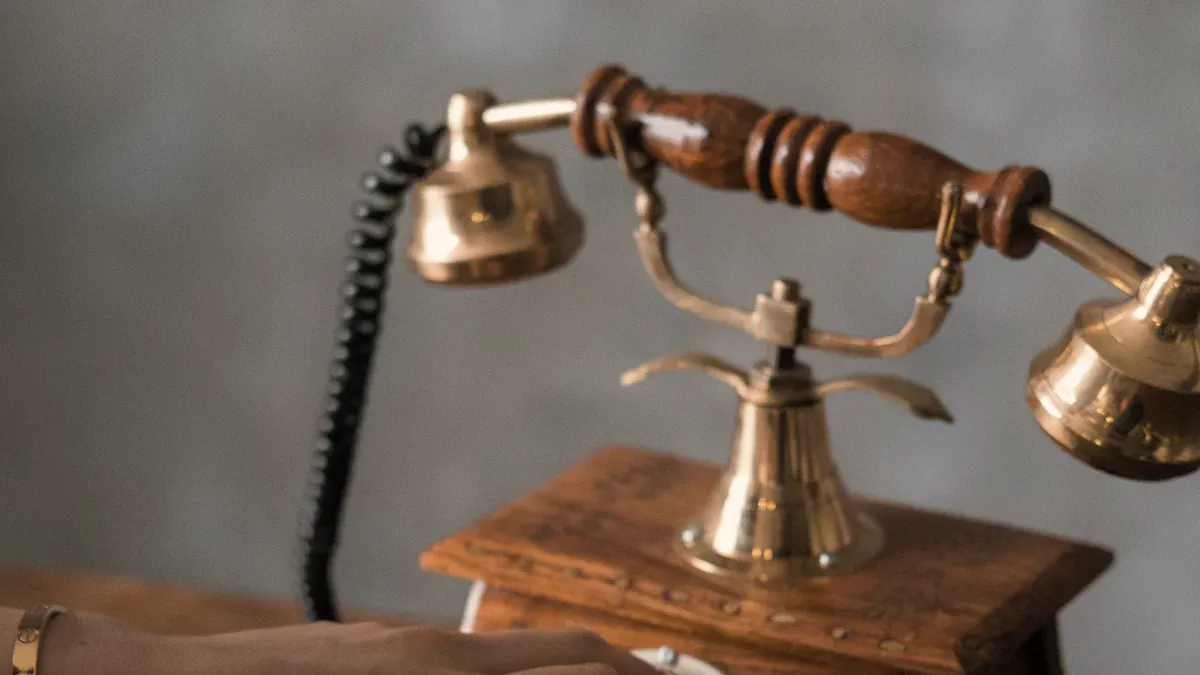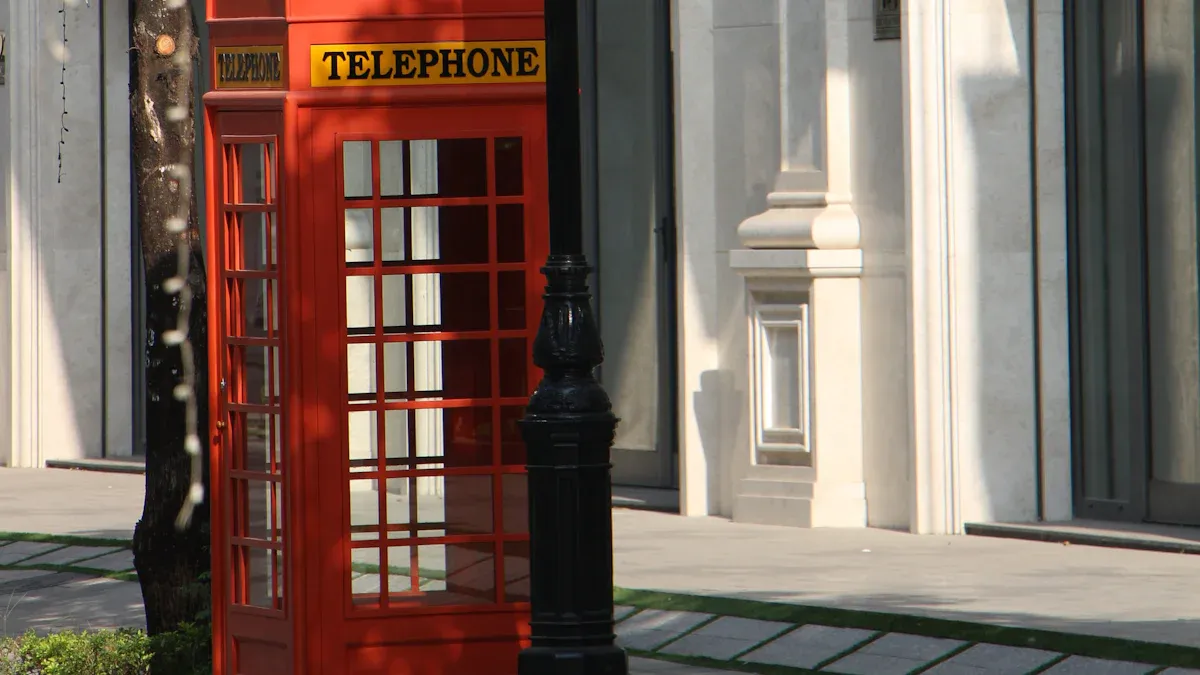
Retro kiosk telephone handsets bring a unique mix of old-school vibes and modern features. They’re perfect for kiosks, public spaces, or even themed setups. Whether it’s a PTT switch telephone handset or an ABS plastic PTT switch industrial telephone handset, these devices always stand out. Their timeless design and practicality make them a favorite choice.
Key Takeaways
- Pick a retro kiosk handset that fits your kiosk’s connection type. Make sure your system works with analog, digital, or VoIP connections.
- Think about the location when choosing wired or wireless handsets. Wired ones are reliable in busy places, while wireless ones are better for quieter areas.
- Choose strong handsets made from good materials like ABS plastic or stainless steel. Find ones that can handle damage and last long, especially in public spots.
Compatibility with Your Kiosk Setup
When choosing a retro kiosk telephone handset, compatibility is one of the first things you should consider. A handset that doesn’t integrate well with your kiosk setup can lead to unnecessary headaches. Let’s break down the key aspects of compatibility to help you make the right choice.
Ensuring Seamless Connectivity
You want a handset that connects effortlessly to your kiosk system. Start by checking the connection type. Does your kiosk support analog, digital, or VoIP systems? Some retro kiosk telephone handsets are designed specifically for one type, while others offer more flexibility.
Tip: If you’re unsure about your kiosk’s connection type, consult the manufacturer’s manual or reach out to their support team. It’s better to confirm upfront than deal with compatibility issues later.
Also, pay attention to the wiring. Poorly connected handsets can result in dropped calls or static noise, which can frustrate users. A seamless connection ensures a smooth experience for everyone.
Wired vs. Wireless Options
Another important decision is whether to go for a wired or wireless handset. Wired handsets are often more reliable and secure, making them a great choice for public kiosks. They’re less prone to interference and don’t require batteries or charging.
On the other hand, wireless handsets offer more flexibility. They’re easier to install and can be moved around without worrying about cables. However, they might not be ideal for high-traffic areas where durability and security are top priorities.
Think about your kiosk’s location and purpose. If it’s in a busy public space, a wired retro kiosk telephone handset might be the better option. But for a themed environment or a less demanding setup, wireless could work just fine.
Integration with Existing Systems
Your kiosk likely has existing systems in place, such as payment terminals, touchscreens, or intercoms. The handset you choose should integrate smoothly with these components. For example, if your kiosk uses a VoIP system, make sure the handset supports it.
Some retro kiosk telephone handsets come with additional features like push-to-talk buttons or volume controls. These can enhance functionality but may require extra setup. Always check if the handset’s features align with your kiosk’s capabilities.
Note: Compatibility isn’t just about technology. It’s also about user experience. A handset that’s easy to use and fits well with your kiosk’s design will leave a lasting impression on users.
Design and Aesthetic Appeal

When it comes to retro kiosk telephone handsets, their design plays a huge role in creating the right vibe. A well-chosen handset can transform your kiosk into a memorable centerpiece. Let’s explore how you can match the style, pick the perfect color, and balance vintage charm with modern functionality.
Matching the Style to Your Environment
Your kiosk’s environment sets the stage for the handset’s design. Is your space sleek and modern, or does it have a nostalgic, vintage feel? A retro kiosk telephone handset can fit into either setting if you choose wisely. For a classic look, go for handsets with rounded edges and timeless details. If your kiosk leans toward a futuristic theme, a handset with subtle retro touches might work better.
Tip: Take a step back and imagine how the handset will look in your space. Does it complement the overall design, or does it stand out awkwardly? A cohesive style makes a big difference.
Exploring Color and Finish Choices
Color and finish can make or break the aesthetic appeal. Retro handsets often come in bold colors like red, black, or even metallic tones. These shades can add a pop of personality to your kiosk. Matte finishes offer a subtle, understated look, while glossy ones bring a touch of elegance.
If you’re unsure, stick to neutral colors like black or white. They’re versatile and blend well with most setups. But don’t be afraid to experiment if your kiosk needs a splash of color to grab attention.
Combining Vintage Looks with Modern Usability
A retro design doesn’t mean outdated functionality. Many retro kiosk telephone handsets combine vintage aesthetics with modern features. For example, you can find handsets with push-to-talk buttons, noise cancellation, or even Bluetooth connectivity. These features make the handset practical while keeping its old-school charm intact.
Note: Always prioritize usability. A handset that looks great but frustrates users won’t leave a good impression. Aim for a balance between style and functionality.
Durability and Build Quality

When choosing a retro kiosk telephone handset, durability is a key factor. You want a handset that can handle daily use and still look great over time. Let’s dive into what makes these handsets tough enough for the job.
Materials for Long-Lasting Performance
The materials used in a handset determine how well it holds up. High-quality materials like ABS plastic or stainless steel are common in retro kiosk telephone handsets. ABS plastic is lightweight yet strong, making it resistant to cracks and breaks. Stainless steel, on the other hand, offers excellent durability and a sleek finish.
Tip: If your kiosk is in a high-traffic area, go for a handset made from industrial-grade materials. It’s a small investment that pays off in the long run.
You should also check for reinforced cords and connectors. These parts often face the most wear and tear. A sturdy cord ensures the handset stays functional even after repeated use.
Resistance to Wear and Vandalism
Public spaces can be tough on equipment. Handsets in kiosks often face rough handling or even vandalism. That’s why you need a handset designed to resist damage. Look for features like tamper-proof screws and shatter-resistant casings. These small details can make a big difference.
Some handsets also come with anti-vandal coatings. These coatings protect the surface from scratches and graffiti. If your kiosk is in a busy or unsupervised area, this feature is worth considering.
Note: A durable handset not only saves you money on replacements but also ensures a better experience for users.
Weatherproofing for Outdoor Use
If your kiosk is outdoors, weatherproofing is a must. Rain, snow, and extreme temperatures can damage a handset that isn’t built for the elements. Many retro kiosk telephone handsets are designed with weather-resistant seals and coatings. These features keep moisture and dust out, ensuring the handset works reliably in any weather.
You should also think about UV resistance. Prolonged exposure to sunlight can fade colors and weaken materials. A UV-resistant handset maintains its appearance and strength, even in sunny locations.
Pro Tip: Always check the IP rating of the handset. An IP rating indicates how well the device is protected against water and dust. For outdoor use, aim for a rating of at least IP65.
Functionality and Features
Enhancing User Experience with Key Features
A great Retro Kiosk Telephone Handset isn’t just about looks. It’s also about how well it works for users. Features like push-to-talk buttons make communication easy and intuitive. These buttons let users speak without holding the handset to their ear, which is perfect for kiosks in busy areas.
Some handsets also include volume controls. These let users adjust the sound to their liking, ensuring a better experience for everyone. If your kiosk serves people with hearing difficulties, this feature can be a game-changer.
Tip: Always test the handset’s features before installation. You want to make sure they’re user-friendly and work as expected.
Importance of Sound Quality and Noise Cancellation
Sound quality matters more than you might think. A handset with poor audio can frustrate users and make communication difficult. Look for models with clear sound output and noise cancellation. Noise-canceling technology filters out background sounds, making conversations clearer even in noisy environments.
For kiosks in crowded places, this feature is essential. It ensures users can hear and be heard without shouting or straining.
Pro Tip: Check reviews or ask for a demo to evaluate the sound quality before buying.
Additional Features like Bluetooth and Volume Control
Modern retro handsets often come with extra features that boost functionality. Bluetooth connectivity is one of them. It allows users to pair the handset with other devices, adding flexibility to your kiosk setup.
Some models also include programmable buttons. These can be customized for specific tasks, like dialing preset numbers or activating kiosk functions.
Note: While these features are handy, make sure they align with your kiosk’s needs. Too many bells and whistles can complicate things unnecessarily.
Ease of Installation and Maintenance
Installation Requirements and Tools
Installing a Retro Kiosk Telephone Handset doesn’t have to be complicated. Start by checking the installation manual that comes with the handset. Most models include clear instructions to guide you through the process. You’ll need basic tools like a screwdriver, a drill, and possibly a wire stripper if the handset requires direct wiring.
Tip: Before you begin, make sure your kiosk is powered off. This prevents accidental damage to the system during installation.
If your handset is wireless, the setup is even easier. You’ll just need to pair it with your kiosk system following the manufacturer’s instructions. Wired handsets might take a bit more effort, but they often come with pre-drilled mounting brackets to simplify the process.
Tips for Long-Term Maintenance
Keeping your handset in top shape doesn’t require much effort. Regular cleaning is key. Use a soft cloth and mild cleaner to wipe down the handset and cord. Avoid harsh chemicals that could damage the finish.
Check the wiring and connectors every few months. Loose connections can lead to poor sound quality or dropped calls. If you notice wear and tear, address it immediately to prevent bigger issues.
Pro Tip: If your kiosk is in a high-traffic area, consider scheduling routine inspections. This helps catch problems early and keeps your handset running smoothly.
Availability of Replacement Parts and Support
Replacement parts are essential for long-term usability. Many manufacturers offer spare cords, buttons, and casings for their handsets. When choosing a Retro Kiosk Telephone Handset, check if the brand provides easy access to these parts.
Customer support is another factor to consider. A responsive support team can help you troubleshoot issues or guide you through repairs. Some brands even offer warranties that cover defects or damage.
Note: Investing in a handset with good support and readily available parts saves you time and money in the long run.
Balancing Cost and Quality
Setting a Realistic Budget
Before you dive into buying a Retro Kiosk Telephone Handset, it’s smart to set a budget. Think about how much you’re willing to spend without stretching your finances. A clear budget helps you narrow down your options and avoid overspending.
Start by considering the purpose of your kiosk. Is it in a high-traffic area where durability is key? Or is it part of a themed setup where design matters most? Knowing your priorities will guide your spending.
Tip: Don’t just focus on the upfront cost. Factor in long-term expenses like maintenance and replacement parts. A slightly higher initial investment can save you money later.
Comparing Features Across Price Points
Not all handsets are created equal, and price often reflects the features you get. Lower-priced models might cover the basics, but they may lack advanced features like noise cancellation or Bluetooth. Mid-range options usually strike a balance between cost and functionality. High-end models often include premium materials and extra features.
Make a list of must-have features. Then, compare models within your budget. This way, you’ll know if you’re getting the best value for your money.
Pro Tip: Don’t pay for features you don’t need. Focus on what adds real value to your kiosk setup.
Evaluating Warranties and Customer Support
A good warranty can be a lifesaver. It protects your investment and gives you peace of mind. Look for handsets with at least a one-year warranty. Some brands even offer extended coverage for an extra fee.
Customer support is just as important. A responsive team can help you troubleshoot issues or find replacement parts. Before buying, check reviews to see how well the company supports its customers.
Note: A reliable warranty and strong customer support can make even a pricey handset worth every penny.
Choosing the right Retro Kiosk Telephone Handset doesn’t have to be overwhelming. Focus on what matters most—compatibility, design, and durability. Think about your kiosk’s needs and your budget. Take your time to research and compare options. The perfect handset is out there, ready to elevate your kiosk experience.
FAQ
What makes retro kiosk telephone handsets different from regular handsets?
Retro handsets combine vintage designs with modern features like noise cancellation and Bluetooth. They’re durable, stylish, and perfect for kiosks or themed environments.
Can I install a retro handset without professional help?
Yes! Most retro handsets come with clear instructions. You’ll need basic tools like a screwdriver. Wireless models are even easier to set up.
Tip: Always check the installation manual before starting. It saves time and prevents mistakes.
Are retro handsets suitable for outdoor kiosks?
Absolutely! Many models are weatherproof and UV-resistant. Look for an IP65 rating or higher to ensure durability in outdoor conditions.
Pro Tip: Regular maintenance keeps outdoor handsets in top shape.


